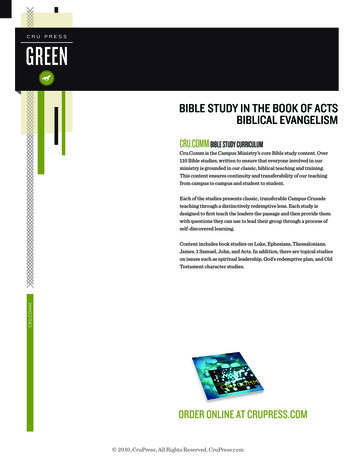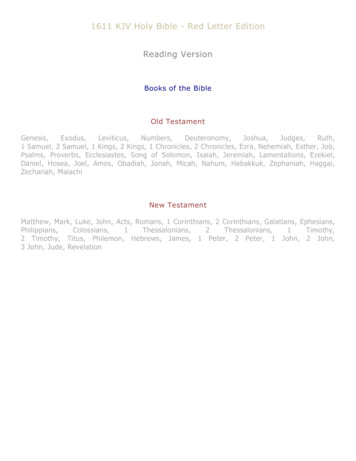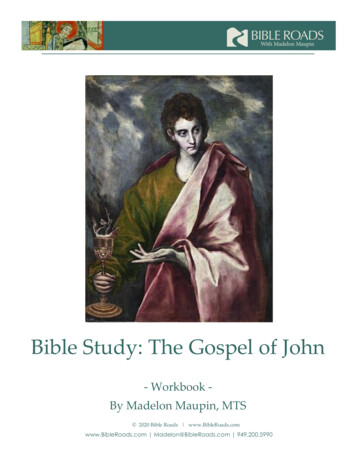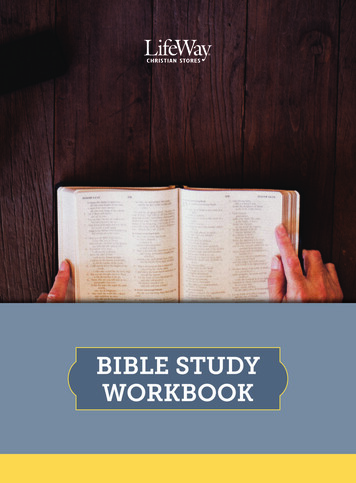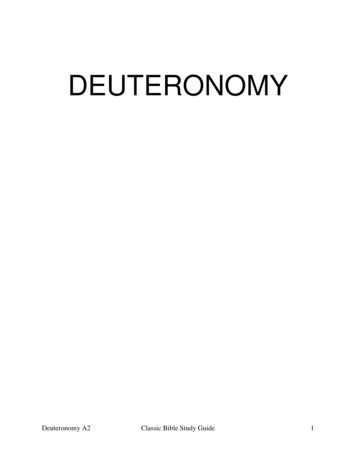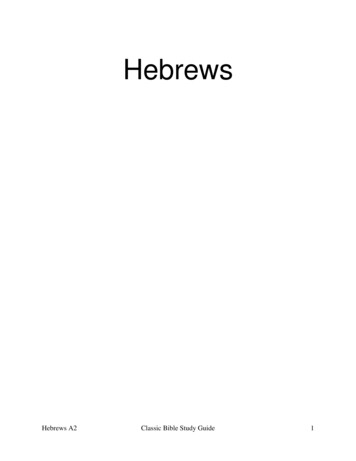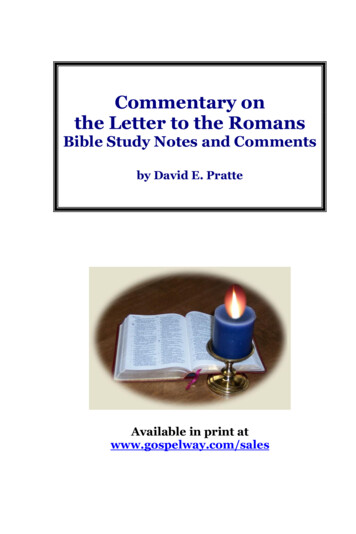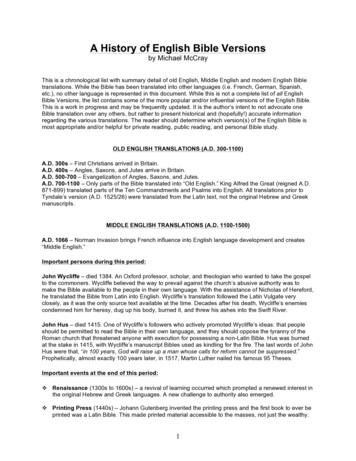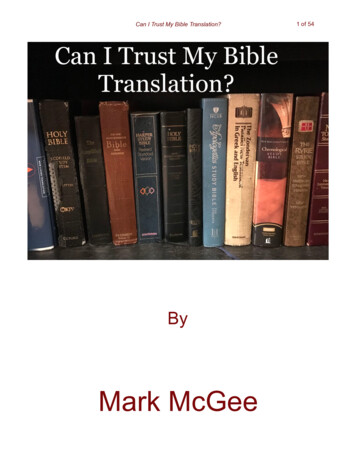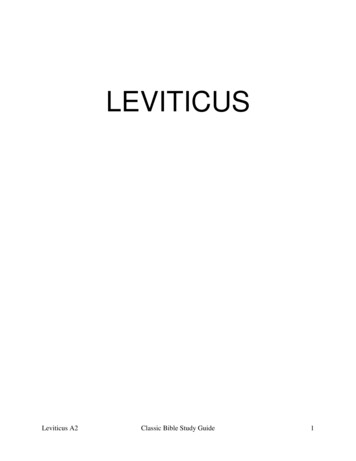
Transcription
LEVITICUSLeviticus A2Classic Bible Study Guide1
INTRODUCTIONAs Genesis is the book of beginnings and Exodus the book of redemption, so Leviticus is the book of reconciliationand fellowship. It brings us into the tabernacle and opens to us all the privileges of access to the presence of God, andour place of blessing as His priestly household. Following are the seven main divisions into which the chapters of thisbook naturally fall.1.2.3.4.5.6.7.The four offerings (chapters 1-7)The priesthood (chapters 8-10)The rites of cleansing (chapters 11-15)The great Day of Atonement as the type (foreshadow) of reconciliation (chapters 16-17)The statutes of holiness (chapters 18-22)Fellowship with God as typified in the great feasts (chapters 23-25)Obedience and faithfulness (chapters 26-27)(The Christ in the Bible, A. B. Simpson)Leviticus A2Classic Bible Study Guide2
Leviticus 1:1–7:38Strictly speaking, we have five offerings described in these chapters, namely: the burnt offering (chapter 1); the grainoffering (chapter 2); the fellowship offering (chapter 3); the sin offering (chapters 4, 5); and the guilt offering (chapter 5).Practically, however, the last two are identical in their main significance, both being of the nature of expiatory offerings totake away the guilt of sin, and its penal consequences. The sin offering was the fundamental one, prefiguring the greatprinciples involved in Christ's propitiation for sin, the guilt offering seeming to refer rather to the provision made in Christ'sdeath, for special acts of transgression and disobedience.The order of Leviticus is at first sight very strange, commencing with the very highest aspect of Christ's sacrifice, andthe one into which we are the last to enter, and closing with the simpler phases of His redeeming work, and those whichwe become first acquainted with in our experience in justification. The explanation is that God is moving outward in thisprogression, and therefore commences at the interior of the tabernacle, where He is at length to bring us, and endsoutside the gate, where He finds us poor, helpless and guilty sinners, and then returns with us through all the stages ofHis gracious plan of salvation, as here unfolded.We shall, therefore, invert the order of these sacrifices in discussing them, not because we question the divine orderand its extreme beauty, but because we desire to lead the reader through the stages of his own experience, and thenreturn with him in the divine order backwards, to contemplate all the riches of grace in Christ Jesus.We shall commence with the sin offering (Leviticus 4:1). It represents Christ's death for us, as God's propitiation forsin. We find three pictures of this sacrifice:1. It was to be offered for the priest (4:1-12).This, however, was not necessary in the case of Christ, who was sinless and needed no atonement for His ownperson (Hebrews 7:27).2. It was offered for the whole congregation (Leviticus 4:13-21).This represents the death of Christ for all men. The several stages of this sacrificial act are full of spiritual significance.The sacrifice was to be offered by the elders of Israel (4:15), and by the laying of their hands upon the head of the victim.So Christ was officially delivered to death by the council of the elders of Israel, as a sacrifice for the entire nation. AndCaiaphas, the high priest, was even inspired to announce to the people the necessity for this substitution.Then the bullock was slain, and its blood sprinkled seven times before the Lord, and before the veil (verses 16, 17).This denotes the death of Christ and the offering of His life to God in place of our forfeited lives, and the perfection of thisoffering as meeting His claim upon our lives.Next, the fat of the bullock was separated and offered to God as a pure sacrifice, implying that there was something inChrist which was directly presented to God, and had no connection with our sin; that is, that His death was an act ofobedience to the Father, as well as a vicarious offering for the guilty (verse 19).Then came the most impressive part of the service. The body of the bullock as an unclean thing was carried outsidethe camp, and burned to ashes as something unfit for sacrifice, and worthy only to be consumed. So Christ was borneoutside the camp, and crucified in ignominy as an accursed thing under the judgment of heaven, and the bane of earth,and literally "made him who had no sin to be sin for us" (2 Corinthians 5:21). Indeed, the word for offering in this passageliterally means sin. So for us the sinless One became as it were, a mass of sin, and an accursed thing (Hebrews 13:12; 2Corinthians 5:21).3. For each individual, the sin offering must also be separately presented. It was not enough that it should have beenoffered by the whole congregation, but each one must separately present an offering for his own sin (Leviticus 4:22-31).So it is not sufficient that Christ has died for the sins of the whole world, but each one of us must appropriate Hissacrifice for our own sins. Two classes are here specified, namely, a leader, verse 22, and one of the common people,verse 27. But with great emphasis it is shown that both must come in the very same way. There is no royal road tomercy. "There is no difference, for all have sinned and fall short of the glory of God" (Romans 3:22-23). Then both mustlay their hands on the head of the sin offering, and thus transfer their guilt to him (verses 24, 29). Both must receiveatonement and forgiveness through the priest (verses 26, 31). In both cases the sprinkling of the blood seven times isomitted, for that was done once for all in the one sacrifice on Calvary; and all that the individual needs to do to be apartaker of the benefits of the sin offering is to recognize his sin, transfer it to the victim and appropriate his forgivenessand cleansing.There are some most vivid and instructive features in this offering, on which for a moment we should dwell.It was the most realistic in its representation of the hideousness of sin of all the Hebrew offerings.Standing before the worshiper was an innocent snow-white lamb, bowing its gentle head at his touch. His soul isstained with guilt and sin, but the lamb had done no wrong. And now he lays his hand on that gentle head, and confessesover it all his guilt. Instantly the sin is transferred to the substitute, and it becomes, as it were, a mass of blackness,loathsomeness and hideous wickedness. Its little life is stricken out as by the blow of vengeance. Its body, laid open—aLeviticus A2Classic Bible Study Guide3
hideous mass of uncleanness and laceration—is dragged from the tabernacle as an offensive and unhallowed thing, andactually called by the very name of sin. It is treated as something unfit to remain for a moment longer in the presence ofGod or His people, and hastily borne outside the camp to the fires where the filth of the camp is consumed, and there ishurled upon the flames and consumed to ashes as a spectacle of vengeance.Transfer all this to the person of Jesus, and behold Him in the place of this suffering lamb, and we have some idea ofwhat is involved in His being "made . sin for us" (2 Corinthians 5:21). Standing in our place, "the L ORD has laid on himthe iniquity of us all" (Isaiah 53:6), and immediately He became, as it were, a mass of inconceivable wickedness, and anaccursed thing in the sight of earth and heaven. The judgments of God fell upon His head. The anathemas and insults ofmen were not too cruel for His deserving. He was treated as though He had committed every abominable crime that manhas ever committed, and as a thing unfit for either earth or heaven. He was nailed to the cross between the heavens andthe earth, as a spectacle of shame and horror, until, consumed by the fires of death and judgment, with Him our sin wasalso consumed forever. This is the meaning of the act of appropriating faith. As we lay our hand upon His innocent head,our sin passes over to His person, and henceforth recognized as consumed and extinguished in the ashes of Hisdissolution. Our guilt, therefore, is declared to be put away and remembered no more, and our very sinfulness may bethus laid upon Him, that "the body of sin might be done away with" (Romans 6:6).What a precious foundation this offering lays, not only for our perfect justification, but for our complete sanctification,and for our deliverance from all the power of evil.The guilt offering (trespass offering), as we have already observed, was a modification of the sin offering, havingreference rather to particular acts of transgression. The laws respecting it are given (Leviticus 5:14-6:7). Many importantlessons are involved in these prescriptions, with reference to the provision which Christ has made for our forgiveness andcleansing.1. Ignorance is no excuse for sin (5:17). "If a person sins and does what is forbidden in any of the LORD's commands,even though he does not know it, he is guilty and will be held responsible." Ignorance may be an extenuation of sin, butGod holds us responsible to know His will as well as to do it. And his ignorance requires forgiveness as well as his sin."The priest will make atonement for him for the wrong he has committed unintentionally" (Leviticus 5:18).2. Confession and restitution must be made, whether it be sin against God or man, and the transgressor must add afifth part to the original amount. God's mercy is founded on righteousness and requires on the part of the transgressor arepentance which is thorough and practical, and proves its sincerity by its fruits. Many souls who are involved in spiritualdarkness, will find the remedy in this divine requirement and no matter what it may cost, it is the only true way to obtainreal and lasting peace and blessing (5:16; 6:4-5).3. Having made confession and restitution, the sin offering must next be presented. This prefigures our appropriationof Christ's blood and righteousness as the ground of our forgiveness.God’s estimate of sin is according to the priest's estimation, and not the sinner's (5:14-6:7). This suggests that man'sestimation of sin is sure to be wrong, and that God only can judge it, and provide a ransom of sufficient value to atone forit. We are to take God's estimate of it and not our own. And if we see it in His light, we shall feel that nothing less than theinestimable value of the Savior's blood can ever expiate its guilt (6:2-5).4. All kinds of sin apply to two classes of trespasses, both those against God and those against our neighbor. Thestandard of sin is made very thorough and searching, and sin against our neighbor is recognized also as sin against theLord.The trespasses provided for in this offering included sins in the holy things of the Lord, disobedience to any of thecommandments of the Lord, falsehood against our neighbor, breach of trust, violence, the deceiving of our brother, thewithholding of that which has been found and false swearing.The offering presented in connection with this sacrifice was probably the same as the ordinary sin offering. In boththese offerings the sacrifice might be either a bullock, a lamb or a dove, according to the ability of the offerer. God'srequirements being tenderly adjusted to the lot and circumstances of each; teaching us that Christ's sacrifice is within thereach of every sinner, however lost and helpless.The fellowship (peace) offering of Leviticus 3:1-17; 7:11-16, 32-34 has special significance in reference to Christ inHis offering of Himself to God as the ground of our peace and communion with the Father.1. The first part of this sacrifice was similar to the other offerings, comprising the selecting of an unblemished animal,the imposition of hands, the slaying of the sacrifice and the sprinkling of the blood. All this was symbolic and wasintended to foreshadow the blood of Christ as the ground of our reconciliation to God, and our justification. . through him to reconcile to himself all things, whether things on earth or things in heaven, by making peacethrough his blood, shed on the cross.Leviticus A2Classic Bible Study Guide4
Once you were alienated from God and were enemies in your minds because of your evil behavior. But now he hasreconciled you by Christ's physical body through death to present you holy in his sight, without blemish and free fromaccusation. (Colossians 1:20-22)2. The special features of the fellowship offering are exceedingly beautiful and instructive. They were intended toexpress the idea of our communion with God, through the offering and intercession of the Lord Jesus Christ. Theyconsisted chiefly of two attractive symbolical acts, the one expressing God's part in this divine fellowship, the other, man's.The whole figure is that of a feast at which two parties sit down together, namely: God and His accepted child, whilethe heavenly bread on which they both feed is the person of Jesus Christ Himself.First, God receives His portion. This was expressed by the offering of the fat and the inwards of the sacrificeexclusively to God. In harmony with this the Jews were prohibited under any circumstances from eating the fat, or drinkingthe blood of animals. The first was regarded as the Lord's and expressive of God's part in the sacrifice of Christ.And the second was the token of Christ's atoning life. The fat of the fellowship offering and the inwards representedthe innermost life and love of Jesus Christ, and that which was highest and divinest in Him; all of which was offered inabsolute devotion and perfect consecration to His Father.There was much more in Christ's death than the atonement of men. Beyond all that it involved for us, there wereelements in His sacrifice which supremely relate to God alone, and meet and satisfy His claims and His affection. In thissense Jesus Christ was an offering to God, as well as a sacrifice for man, and so became the very bread of God, as wellas of the believing soul. Therefore when we come to God in communion, we bring to Him as set forth in this sacrifice theLord Jesus Christ, as His part in the feast. Not only are we accepted on the ground of His finished work, and perfectrighteousness, but we offer afresh to God in active and living faith, and worship, His loveliness, and the sweet incense ofHis person and character. And if He is living in us, we offer to God not only the historical Christ, as the abstractembodiment of virtue and goodness, but His actual and living Spirit, as the very life of our being, and the incense of ourhearts, and are delightfully conscious that what we present to God is not our own love or devotion, but the Spirit of Christliving and loving and springing within us. So "we are to God the aroma of Christ" (2 Corinthians 2:15) and are "acceptedin the Beloved" (Ephesians 1:6, KJV).This is God's portion in the feast of the fellowship offering. But this having been offered, we next receive our portionfrom His hand. This was also expressed in the ancient fellowship offering by the portion of the sacrifice which was givento the priests as their part in the banquet. These priests represented all consecrated believers under the gospel.After the priest had offered the fat and the sacrifice, he also sat down to partake of the right shoulder and the breast ofthe lamb (Leviticus 7:32-34). The former prefigured the strength of the Lord Jesus Christ, which becomes the very lifeand strength of the consecrated heart, and on which we may sweetly feed, and thus put on His strength, and so become"strong in the Lord and in his mighty power" (Ephesians 6:10).The breast signifies the love of Jesus. This also becomes our life. All the tenderness of His affection, all thesweetness of His sympathy, all the intimacy of His friendship, all the blessedness of His care, all the power of Hisindwelling life and love are thus made our own. Feeding upon His breast, not only do we enjoy His love to us in all itsfullness, but we absorb and assimilate into our very being His own nature which is love—His spiritual life, His holy will, Hisdevotion to God, His tenderness, His meekness and patience. This is the secret of holiness. This is true sanctification.Thus only can we love the Lord our God with all our heart and our neighbor as ourselves. Thus only can we love oneanother as He has loved us. This is the feast to which He invites His people."Here I am! I stand at the door and knock. If anyone hears my voice and opens the door, I will come in and eat withhim, and he with me" (Revelation 3:20). This is the secret of His inner fellowship, which the men of Capernaum could notunderstand and would not receive. "I am the living bread that came down from heaven. . . . Whoever eats my flesh anddrinks my blood has eternal life, and I will raise him up at the last day. . . . Just as the living Father sent me and I livebecause of the Father, so the one who feeds on me will live because of me" (John 6:51, 54, 57).There were minute features in this beautiful offering, which shed still fuller light on these profound lessons. The fleshof the fellowship offering was to be eaten the same day that it was offered (Leviticus 7:15); teaching us that there can beno stale experience in a true Christian life, but our fellowship with Christ must be continually renewed and we must abidein Him by living faith, moment by moment, and not live on old memories and experiences.The fellowship offering also was always made by fire. And so the Holy Spirit alone can quicken and make real ourcommunion with Christ and our participation in His life.There was one singular provision in connection with this sacrifice, permitting the offering of leavened bread inconnection with the thanksgiving oblation (7:13). Unleavened cakes mingled with oil were first to be offered, and thenleavened cakes were mingled with them. When we remember that leaven was the type of sin, it looks very strange thatsuch an expiation should be permitted. But it seems to imply that even the soul that is not yet fully sanctified may enjoythis communion with Christ. At the same time it gives no tolerance to known or indulged sin. For it is expressly providedin the 20th verse of the same chapter, that the soul that ate of the flesh of the sacrifice of fellowship offerings, inuncleanness, "must be cut off from his people."Leviticus A2Classic Bible Study Guide5
It would seem to show that even a soul not yet freed from the leaven of natural corruption may come into thesanctuary and offer to God the perfect sacrifice of Christ, and feed upon it, notwithstanding his own worthlessness,provided that all known sin has been acknowledged and renounced, and his uncleanness laid over upon the sin offeringand renounced in his repentance and renewed obedience.The grain offering (Lev. 2:1-16) signifies Christ in His perfect human life, as the satisfaction of His Father, and thesupply of His people's needs. It was a bloodless offering, but after the institution of the fellowship offering, it was usuallyconnected with that offering, showing us that the life of Christ is not to be separated from His death, but becomes our truebread, as it is connected with His atonement, His mere teaching and example requiring the addition of His blood to formthe perfect supply of our spiritual need (see 7:12).1. The grain offering consisted of fine flour, typical of Christ's perfect humanity (2:4; 1 Peter 2:22). There wassomething exquisitely and infinitely perfect about Christ's whole person. Every fiber of His being was fine and infinitelysensitive to suffering, joy and every touch of His Father's will.2. The fine flour of the meat offering was mingled with oil, which was typical of the Holy Spirit's union with Christ, bothin His birth, His baptism and His entire ministry (Luke 1:35; 3:22; 4:1).3. The grain offering consisted also of frankincense, which was typical of the intense devotion of Christ's heart to theglory of His Father and of the sweetness and love which characterized His Spirit (John 8:27; Ephesians 5:2).4. The grain offering was accompanied by unleavened cakes, the absence of leaven implying the perfect purity ofChrist's character and life (Hebrews 7:26; 1 Corinthians 5:7).5. The absence of honey in the grain offering strikingly expresses the freedom of His Spirit from all mere humansweetness, whether of sentiment, passion, self-indulgence or earthliness of any sort; the sickly sweet which manypersons mistake for spiritual loveliness, and which belongs to much which is merely earthly and human (Leviticus 2:2;John 2:4; Luke 9:59; Mark 3:35; Matthew 12:50).6. The grain offering was mingled with salt (Leviticus 2:13). This is expressive of that quality in Christ's characterwhich may be best expressed, perhaps, by the term wholesome; the intense practical wisdom and sense which kept Himfrom committing Himself to any man, from ever being weak or foolish, or in any way betraying Himself to His enemies.The same quality is expressed by the apostle in his counsel to us: "Let your conversation be always full of grace,seasoned with salt, so that you may know how to answer everyone" (Colossians 4:6).7. The grain offering was offered with fire, perhaps suggesting Christ's suffering life and also the quickeninginfluences of the Holy Spirit.8. The grain offering was first presented to God and then partaken of by the worshiper. So Christ's life was God'sbread and thus becomes also ours, as we have already seen in the deeper teaching of the fellowship offering. This entireoffering thus represented the beauty and purity of Christ's life as the satisfaction of God, the strength of our life, and inconjunction with the fellowship offering, the supply of our spiritual need.The burnt offering (Lev.1:1-17) was the crowning sacrifice of the Levitical economy and expresses the highestelements in the offering of the Lord Jesus Christ and the believer's entire consecration.Its highest import was to express and prefigure Christ's spotless, sufficient and complete self-sacrifice to God. Itproceeded on the assumption that the sin had already been expiated by the sin offering, and hence a sinless sacrifice waslaid upon the altar and consumed to ashes as a sweet savor, every part acceptable to Jehovah, to whom it was whollydedicated. It was thus an offering to God, rather than for man.The very name used to describe it literally means "to ascend," suggesting this thought of entire dedication to Jehovah.It becomes, therefore, a type of Christ offering Himself to the Father in our stead, and then offered by us in faith and fullconsecration.1. It must be without defect (1:3). The very essence of Christ's sacrifice for us involved the condition of His absolutesinlessness. Presenting Him to God we know that our offering must be accepted, and that the Father will say, "with him Iam well pleased" (Matthew 3:17).2. It must be willingly given. So He came crying, "Here I am, . I desire to do your will, O my God" (Psalm 40:7a, 8a)."No one takes it from me, but I lay it down of my own accord" (John 10:18). When they came to arrest Him, He showedLeviticus A2Classic Bible Study Guide6
by His miraculous power in prostrating the officers by a look that He might easily have escaped had He wished; but Heoffered Himself to die in our stead, a willing sacrifice.3. It was slain before the Lord (Leviticus 1:5). So Christ yielded up His life, not only in the sight of men, but before theLord. "Yet it was the LORD's will to crush him and cause him to suffer, and though the L ORD makes his life a guilt offering ." (Isaiah 53:10). Like Abraham's sacrifice of his son, so the Father was the chief Actor in the scene, and also the chiefWitness. And He looked upon that bleeding cross and dying Victim, and He knew that there was nothing withheld.4. The blood was sprinkled round about the altar. This expresses the presenting of Christ's life, of which the bloodwas ever the symbol, as a ransom for sinful men, whose lives had been forfeited because of sin, and have beenredeemed by the precious blood of Christ (Leviticus 1:5).5. The sacrifice was next flayed, and cut into pieces, and thus exposed in every part, naked and open for inspection inevery particular (1:6). This was intended to show that Christ's life was fully disclosed to the keenest inspection of HisFather's eye, and offered to God in all the minute details of His being, His consecration extending to every thought, everymoment and every issue of His existence. His whole life was a burnt offering, and in His death every detail was whollyconsecrated and held upon the altar until the sacrifice was complete.This is the reason why the last sufferings of our Lord are so fully described, and why the scene of agony was soprotracted and minute. It was the cutting of the burnt offering into its innumerable pieces, and the presenting of each indetail, until there was nothing that could be added to the cup of pain, and the sacrifice of love. So our consecration mustbe specific and explicit, covering the minutest details of our life and actions.6. The burnt offering was next laid upon the altar, over the wood and the fire, and wholly burnt to ashes (1:7-9). Thiswas fulfilled in the consuming fire of Christ's sufferings both in life and death, under the hand of God and in the ascendingflames of His own entire self-sacrifice and love. The entire burnt offering was consumed on the altar, and so Christ waswholly given to God.All His life was offered, and every drop of His blood shed through the spear wound in His side. It is the completenessof the offering that makes it a perfect type of our consecration.7. The burnt offering was to be continually kept upon the altar (6:9-13). So Christ's sacrifice was as unceasing as Hislife. Indeed, it has not ceased, in the sense of His entire consecration, even with His death.8. Christ's offering thus wholly made was perfectly accepted by the Father, and is called "a fragrant offering andsacrifice to God" (Ephesians 5:2). The whole idea of the burnt offering is that of sweetness and acceptance. There is notany odor of sin about it, but it breathes the very incense of sweetness and love; and God delights in it and requires that itsfragrant breath shall continually ascend before Him.So the Lord Jesus Christ has fully satisfied all the claims of the law and all the expectations of the Father. For agesGod had been looking down in vain to find in the human race one in whom He could completely delight. "I looked for aman," He says, "but I found none" (Ezekiel 22:30). At length His heart rested on His beloved Son. In Him He found, forthe first time, one of whom He could say, "with him I am well pleased" (Matthew 3:17), and for His sake He has loved andaccepted sinful man ever since.It is most important that we should recognize God's rights and claims in the work of redemption, as well as thenecessities of lost men. Even if no mortal should ever be saved, God was entitled to obedience and love from thosewhom He had created at such cost. And even if Christ's life and death had never brought a soul to heaven, it has at leastsatisfied the claims of heaven upon the human family and honored the character and law of God.9. One of the most vital acts in the sacrifice of burnt offering was the imposition of hands on the part of the worshiper(Leviticus 1:4) by which he identified himself with the sacrifice and so became accepted in its acceptance. This is a figureof the act of appropriating faith by which we accept the Lord Jesus Christ as our righteousness and present Him to God asthe ground of our acceptance, and so are made accepted in Him even as He is accepted.10. This beautiful offering not only typifies the sacrifice of Christ, but also becomes the pattern of our trueconsecration to God. From each of us God rightly claims, in the light of His most searching presence, the willing andentire surrender and dedication of our entire being, and the consecration of every detail of our life. Like Him, too, ourwhole life should be a continual ascending flame of love and service on His holy altar, so that the Father can say of us asof Him; "My Son, whom I love; with him I am well pleased" (Matthew 3:17).The only way in which we can ever make this offering is by receiving the Lord Jesus Christ into our very life andbeing, and becoming so identified with Him that we can continuously present Him in our heart of hearts as the very life ofour life. This was what He Himself meant when He said: "For them I sanctify myself, that they too may be truly sanctified"(John 17:19). It is only as He thus lives in us that we can be truly consecrated, and that God can ever take pleasure in us.Leviticus A2Classic Bible Study Guide7
The 12th chapter of Romans is God's exposition of the burnt offering, as the sixth chapter is of the sin offering.Let us hear the divine call afresh in beautiful type: "I urge you, brothers, in view of God's mercy, to offer your bodiesas living sacrifices, holy and pleasing to God—this is your spiritual act of worship" (Romans 12:1). And in order that wemay fulfill this consecration, let us receive Him who has already fulfilled it as our indwelling life and righteousness; andthen we shall give back to God that which is but His own, and which He has already accepted in the person of His belovedSon.(The Christ in the Bible, A. B. Simpson)Most think of Leviticus as rather dry reading, but Pastor Simpson’s opening statements introduce us to the wonder ofGod’s ways, by showing that this book begins with the very highest aspect of Christ’s sacrifice, then works on down in thesacrifices to the one where we come in—as guilty sinners bringing an offering for sin and guilt. How gracious of God tofirst give us a glimpse of the place of glory to which He longs to bring us! Pastor Simpson takes an inverted study ofthese offerings in order to lead each one of us through our own experience, and also for us to begin to grasp how rich isHis grace toward us—for He found us—we d
Leviticus A2 Classic Bible Study Guide 2 INTRODUCTION As Genesis is the book of beginnings and Exodus the book of redemption, so Leviticus is the book of reconciliation and fellowship. It brings us into the tabernacle and opens to us all the privileges of access to the presence of


